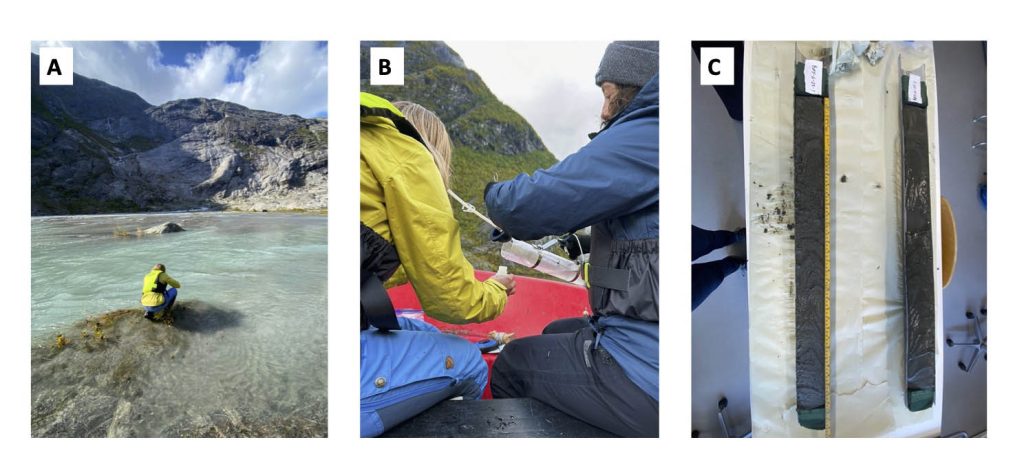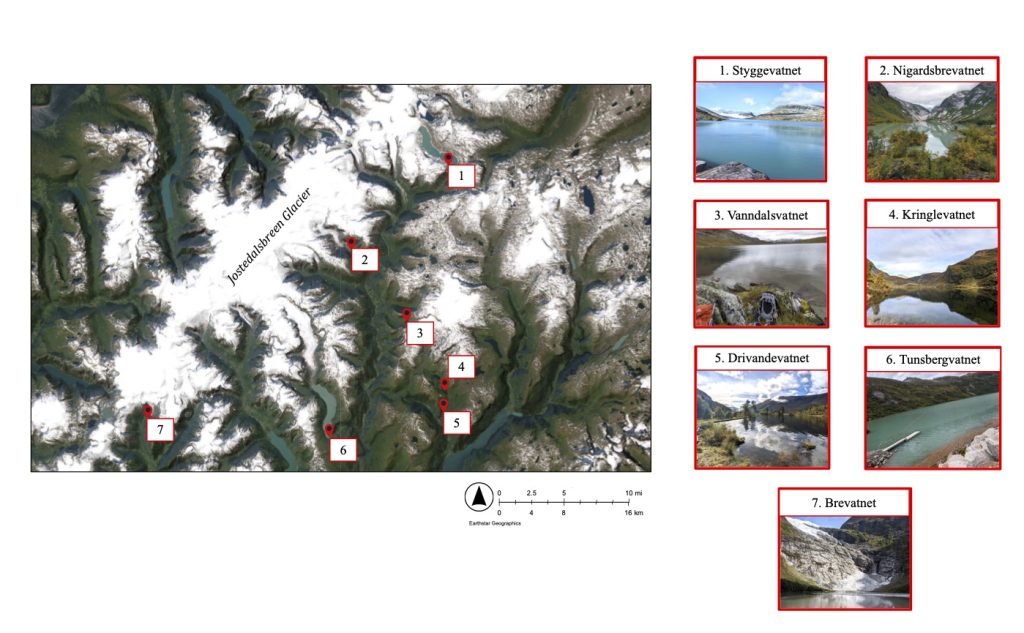
Assessing temporal patterns and ecosystem consequences of biogeochemical change in glacially fed lakes in Western Norway
Expedition Location: Vestland, Norway
Expedition Dates: August 29th 2023 – September 29th 2023
Field Team Members: Ansley Grider (MS Student, UMaine) Field Trip Leader, Jasmine Saros (Professor, UMaine)
Funding Support: Dan & Betty Churchill Exploration Fund
Background & Significance:
Glaciers are located at an interface between the atmospheric and terrestrial environments, making them potential hot spots for atmospherically derived materials (Slemmons et al., 2013). Atmospherically derived materials, such as dust, nutrients, metals, and contaminants, can accumulate in glaciers over hundreds or even thousands of years, because (1) glaciers and ice sheets are long-lived and (2) materials move slowly through glaciers and ice sheets (Beard et al., 2022a). However, the materials that have accumulated in glaciers over many years are now melting out at high rates due to warming temperatures caused by climate change (Beard et al., 2022b). Surface temperatures in the Arctic have risen by almost 3°C since the mid-1960s (Ballinger et al, 2021). As glacial melt increases due to rising temperatures, meltwater flux to downstream ecosystems, such as lakes, has risen. Global glacial-lake volume increased dramatically – by 48% – and lake numbers increased by 53% between 1990 and 2018 (Shugar et al., 2020). In Norway, there has been an overall 15% decline in total glacier area, causing 360 new glacial lakes to form in the country (Andreassen et al., 2022). The biogeochemistry of these lakes might be changing due to the rapid release of glacially derived materials in meltwater. However, few studies have investigated how the biogeochemistry of glacial lakes are changing in today’s climate.
Field Report:
In September 2023, my advisor Jasmine Saros and I conducted research on lakes near the Jostedalsbreen glacier in Norway (Figure 1). We took water samples from four glacially fed lakes and three non-glacially fed lakes (Figure 2). The samples will be analyzed for dissolved nitrogen, total phosphorus, and a suite of heavy metal concentrations. Nigardsbrevatnet, which is one of the glacially fed lakes we sampled from, experienced a 50-year flood the day prior to our sample collection. Because of that, we decided to take another collection of water samples from Nigardsbrevatnet a month post-flood. This will allow us to study the biogeochemical impacts of the flood. We also collected a sediment core from the glacial lake Brevatnet, and we will be analyzing the sediment for total nitrogen, heavy metals, diatom species richness, and diatom morphological deformations. With the help of our Norwegian colleagues, we are hoping to get a sediment core from the glacial lake Nigardsbrevatnet this winter. Our analyses will allow us to answer questions such as the temporal changes in the biogeochemistry of glacial lakes, differences between glacial and non-glacial lakes, and how extreme events are affecting these freshwater systems.


References:
Andreassen, L. M., Nagy, T., Kjøllmoen, B., & Leigh, J. R. (2022). An inventory of Norway’s glaciers and ice-marginal lakes from 2018–19 Sentinel-2 data. Journal of Glaciology, 68(272), 1085–1106. https://doi.org/10.1017/jog.2022.20
Ballinger, T. J., Overland, J. E., Wang, M., Bhatt, U. S., Brettschneider, B., Hanna, E., Hanssen-Bauer, I., Kim, S.J., Thoman, R. L., Walsh, J. E. (2021). NOAA Arctic Report Card 2021: Surface Air Temperature. https://doi.org/10.25923/53XD-9K68
Beard, D. B., Clason, C. C., Rangecroft, S., Poniecka, E., Ward, K. J., & Blake, W. H. (2022a). Anthropogenic contaminants in glacial environments I: Inputs and accumulation. Progress in Physical Geography: Earth and Environment, 46(4), 630–648.
Beard, D. B., Clason, C. C., Rangecroft, S., Poniecka, E., Ward, K. J., & Blake, W. H. (2022b). Anthropogenic contaminants in glacial environments II: Release and downstream consequences. Progress in Physical Geography: Earth and Environment, 030913332211273. https://doi.org/10.1177/03091333221127342
Slemmons, K. E. H., Saros, J. E., & Simon, K. (2013). The influence of glacial meltwater on alpine aquatic ecosystems: a review. Environmental Science: Processes & Impacts, 15(10), 1794–1806.
Shugar, D. H., Burr, A., Haritashya, U. K., Kargel, J. S., Watson, C. S., Kennedy, M. C., Bevington, A. R., Betts, R. A., Harrison, S., & Strattman, K. (2020). Rapid worldwide growth of glacial lakes since 1990. Nature Climate Change, 10(10), 939–945.

